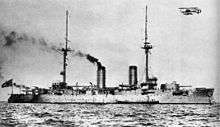
Yamato and Musashi, the two largest battleships ever built
In the late 19th century, the strategy of the Imperial Japanese Navy (IJN) was based on the radical Jeune Ecole naval philosophy, as promoted by French military advisor and naval architect Emile Bertin. This emphasized cheap torpedo boats and commerce raiding to offset expensive, heavily armoured ships. The acquisition of two German-built Dingyuan-class ironclads by the Imperial Chinese Beiyang Fleet in 1885 threatened Japan's interests in Korea. A visit by the Chinese warships to Japan in early 1891 forced the Japanese government to acknowledge that the IJN required similarly armed and armoured ships of its own to counter the ironclads; the three lightly armored Matsushima-class cruisers ordered from France would not suffice, despite their powerful guns. The IJN decided to order a pair of the latest battleships from the United Kingdom[1] as Japan lacked the technology and capability to construct its own battleships.[2]
Combat experience in the First Sino-Japanese War of 1894–95 convinced the IJN that the Jeune Ecole doctrine was untenable. Therefore, Japan promulgated a ten-year naval build-up in early 1896, to modernize and expand its fleet in preparation for further conflicts, with the construction of a total of six battleships and six armored cruisers at its core.[3] These ships were provided for from the £30,000,000 indemnity paid by China after losing the First Sino-Japanese War and the four remaining battleships of the program were also built in the UK.[4]
Rising tensions between the Japanese and the Russian Empire over control of Korea and Manchuria in the early 1900s caused the former to begin the Russo-Japanese War of 1904–5 with a surprise attack on the Russian base at Port Arthur. The Imperial Japanese Army captured the port, and the surviving ships of the Pacific Squadron by the end of the year, but the Russians had dispatched the bulk of their Baltic Fleet to relieve Port Arthur before then. It did not reach the Korea Strait until May 1905 and was virtually annihilated by the IJN in the Battle of Tsushima despite significantly outnumbering the Japanese. During the war, Japan captured a total of six Russian pre-dreadnoughts. These were all repaired and commissioned into the Japanese fleet; of these, three were later returned to Russia during World War I, as the two countries were by then allies. The magnitude of the victory at Tsushima caused the leadership of the IJN to believe that a surface engagement between the main fleets was the only decisive battle in modern warfare and would be decided by battleships armed with the largest guns. The corollary to this was that Japanese ships had to be qualitatively superior to those of their opponents to ensure victory.[5]
After the war, the Japanese Empire immediately turned its focus to the two remaining rivals for imperial dominance in the Pacific Ocean: Britain and the United States.[6] Satō Tetsutarō, an IJN admiral and military theorist, speculated that conflict would inevitably arise between Japan and at least one of its two main rivals. To that end, he called for the IJN to maintain a fleet with at least 70% as many capital ships as the US Navy. This ratio, Satō theorized, would enable the Imperial Japanese Navy to defeat the US Navy in one major battle in Japanese waters in any eventual conflict. Accordingly, the 1907 Imperial Defense Policy called for the construction of a battle fleet of eight modern battleships, 20,000 long tons (20,321 t) each, and eight modern armored cruisers, 18,000 long tons (18,289 t) each.[7] This was the genesis of the Eight-Eight Fleet Program, the development of a cohesive battle line of sixteen capital ships.[8]
The launch of HMS Dreadnought in 1906 by the Royal Navy raised the stakes,[9] and complicated Japan's plans as she rendered all existing battleships obsolete.[10] The launch of the battlecruiser HMS Invincible the following year was a further setback for Japan's quest for parity.[11] When the two new Satsuma-class battleships and two Tsukuba-class armored cruisers, launched by 1911, were outclassed by their British counterparts, the Eight-Eight Fleet Program was restarted.[12]
The first battleships built for the renewed Eight-Eight Fleet Program were the two dreadnoughts of the Kawachi class, ordered in 1907 and laid down in 1908. In 1910, the Navy put forward a request to the Diet (parliament) to secure funding for the entirety of the program at once. Because of economic constraints, the proposal was cut first by the Navy Ministry to seven battleships and three battlecruisers, then by the cabinet to four armored cruisers and a single battleship. The Diet amended this by authorizing the construction of four battlecruisers (the Kongō class) and one battleship, later named Fusō, in what became the Naval Emergency Expansion bill.[13]
Pre-Dreadnoughts
Fuji class

Fuji at anchor, c. 1908
The Fuji-class ships were the first battleships in the IJN, and were ordered in response to the Chinese acquisition of two ironclad battleships. The design for Fuji was based on the Royal Sovereign-class battleships being built for the Royal Navy at that time, albeit slightly smaller and faster with improved armor and guns.
The ships participated in the Russo-Japanese War of 1904–1905, including the Battle of Port Arthur in February 1904 and two bombardments of Port Arthur during the following month. Yashima struck a mine off the city in May and capsized while under tow several hours later. Fuji fought in the Battles of the Yellow Sea and Tsushima and was lightly damaged in the latter action. She was reclassified as a coastal defence ship in 1910 and served as a training ship for the rest of her active career. The ship was hulked in 1922 and converted into a barracks ship fitted with classrooms. Fuji was finally broken up for scrap in 1948.
Shikishima class

Shikishima in 1905
The design of the Shikishima class was a modified and improved version of the Majestic-class battleships of the Royal Navy. They had the same armament and similar machinery as the Fuji class which was intended to allow them to work together as a homogenous group.[22] The ships participated in the Russo-Japanese War, including the Battle of Port Arthur on the second day of the war. Hatsuse sank after striking two mines off Port Arthur in May 1904. Shikishima fought in the Battles of the Yellow Sea and Tsushima and was lightly damaged in the latter action, although shells prematurely exploded in the barrels of her main guns in each battle. The ship was reclassified as a coastal defence ship in 1921 and served as a training ship for the rest of her career. She was disarmed and hulked in 1923 and finally broken up for scrap in 1948.
Asahi

Asahi in July 1900
Asahi's design was a modified version of the Formidable-class battleships of the Royal Navy, with two additional 6-inch (152 mm) guns.[25] Shortly after her arrival in Japan, she became flagship of the Standing Fleet, the IJN's primary combat fleet. She participated in every major naval battle of the Russo-Japanese War and was lightly damaged during the Battles of the Yellow Sea and Tsushima. Asahi saw no combat during World War I, although the ship participated in the Siberian Intervention in 1918.
Reclassified as a coastal defence ship in 1921, Asahi was disarmed two years later to meet the terms of the Washington Naval Treaty, after which she served as a training and submarine depot ship. She was modified into a submarine salvage and rescue ship before being placed in reserve in 1928. Asahi was recommissioned in late 1937, after the start of the Second Sino-Japanese War, and used to transport Japanese troops. In 1938, she was converted into a repair ship and based first at Japanese-occupied Shanghai, China, and then Camranh Bay, French Indochina, from late 1938 to 1941. The ship was transferred to occupied Singapore in early 1942 to repair a damaged light cruiser and ordered to return home in May. She was sunk en route by the American submarine USS Salmon, although most of her crew survived.
Mikasa
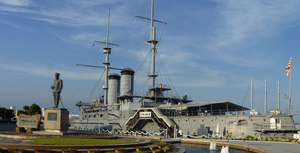
Mikasa as a museum ship, 2010
Tango

Tango at anchor, c. 1908–09
Peresvet class

Sagami, still in Russian service as Peresvet in 1901
Hizen
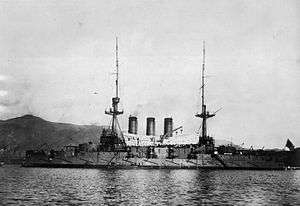
Hizen at anchor
Iwami
Katori class

Kashima shortly after entering service in 1906
Satsuma class

Postcard of Satsuma at anchor
Dreadnoughts battleships
Kawachi class
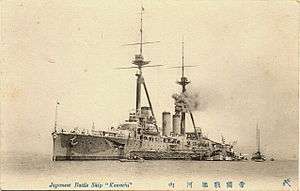
Postcard of Kawachi
Fusō class

Fusō on trials in 1933 after her modernization
Ise class

Ise underway after her modernization
Nagato class
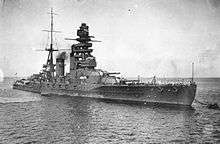
Nagato at anchor, c. 1924
Tosa class

Scale model of Kaga, had she been completed as a battleship
Kii class
Number 13 class

Line-drawing of the No. 13 design
Yamato class

Yamato on trials in 1941
Design A-150
- ↑ Evans & Peattie, pp. 15, 19–20, 60
- ↑ Brook 1999, p. 123
- ↑ Evans & Peattie, pp. 15, 57–60
- 1 2 3 4 5 Brook 1999, p. 125
- ↑ Evans & Peattie, pp. 85–86, 110, 116–32
- ↑ Stille, p. 4
- ↑ Evans & Peattie, pp. 143, 150
- ↑ Stille, p. 7
- ↑ Evans & Peattie, p. 152
- ↑ Sandler, p. 90
- ↑ Evans & Peattie, p. 154
- ↑ Evans & Peattie, p. 159
- ↑ Evans & Peattie, p. 160
- ↑ All figures are for the ship as completed
- ↑ Lengerer 2009, pp. 27, 36
- 1 2 Jentschura, Jung & Mickel, p. 16
- ↑ Lengerer September 2008, pp. 23, 27
- 1 2 3 4 5 Silverstone, p. 327
- 1 2 Silverstone, p. 328
- ↑ Brook 1985, p. 268
- 1 2 Jentschura, Jung & Mickel, p. 17
- ↑ Chesneau & Kolesnik, p. 221
- 1 2 3 Brook 1999, p. 126
- ↑ Brook 1999, pp. 125–26
- ↑ Preston, p. 189
- ↑ Lengerer September 2008, p. 27
- 1 2 Jentschura, Jung & Mickel, p. 18
- ↑ Lengerer September 2008, pp. 22, 24, 26
- ↑ Silverstone, p. 326
- ↑ Lengerer September 2008, p. 30
- ↑ Hackett & Kingsepp
- ↑ Chesneau & Kolesnik, p. 222
- ↑ Jentschura, Jung & Mickel, pp. 18–19
- 1 2 Silverstone, p. 334
- ↑ Corkill, Ednan (18 December 2011). "How The Japan Times Saved a Foundering Battleship, Twice". The Japan Times. Retrieved 2 August 2012.
- 1 2 3 4 McLaughlin 2003, pp. 84–85, 90
- ↑ McLaughlin 2003, pp. 84, 86, 90
- ↑ Silverstone, p. 337
- ↑ Watts & Gordon, p. 26
- ↑ McLaughlin 2003, p. 91
- 1 2 3 4 5 McLaughlin 2003, pp. 107–08, 112–14
- ↑ McLaughlin 2003, p. 107
- ↑ McLaughlin 2008, p. 46
- ↑ Preston, p. 207
- ↑ McLaughlin 2003, p. 108
- ↑ McLaughlin 2003, p. 48
- ↑ McLaughlin 2008, p. 49
- ↑ McLaughlin 2000, p. 57
- 1 2 McLaughlin 2000, pp. 54–55
- ↑ McLaughlin 2000, p. 54
- ↑ McLaughlin 2000, p. 64
- ↑ McLaughlin 2000, p. 64
- ↑ McLaughlin 2003, p. 142
- ↑ McLaughlin, pp. 136–37
- 1 2 McLaughlin 2003, p. 136
- ↑ McLaughlin 2003, pp. 137, 144
- ↑ Forczyk, pp. 70–71
- ↑ Lengerer September 2008b, p. 66
- 1 2 Gardiner & Gray, p. 227
- 1 2 3 Jentschura, Jung & Mickel, p. 22
- 1 2 3 4 Silverstone, p. 332
- 1 2 Brook 1985, p. 282
- 1 2 3 4 5 6 Jentschura, Jung & Mickel, p. 23
- 1 2 3 4 5 6 Silverstone, p. 336
- 1 2 3 4 5 Jentschura, Jung & Mickel, p. 24
- 1 2 3 4 5 6 7 8 9 10 Gardiner & Gray, p. 229
- ↑ Jentschura, Jung & Mickel, p. 25
- 1 2 Silverstone, p. 328
- 1 2 Silverstone, p. 339
- 1 2 3 4 5 6 Gardiner & Gray, p. 230
- 1 2 3 4 Whitley, p. 193
- 1 2 3 4 5 6 Gardiner & Gray, p. 231
- 1 2 3 4 Whitley, p. 200
- 1 2 3 4 5 6 7 8 9 10 11 12 Gardiner & Gray, p. 232
- ↑ Lengerer 2010, p. 26
- 1 2 3 4 Gardiner & Gray, p. 235
- 1 2 3 4 5 6 7 8 9 10 11 12 13 14 Chesneau, p. 178
- ↑ Chesneau, p. 184
- ↑ Garzke & Dulin, p. 85
- ↑ Breyer, p. 330
References
- Breyer, Siegfried (1973). Battleships and Battle Cruisers, 1905–1970. Garden City, New York: Doubleday. OCLC 702840.
- Brook, Peter (1985). "Armstrong Battleships for Japan". Warship International. Toledo, Ohio: International Naval Research Organization. XXII (3): 268–82. ISSN 0043-0374.
- Brook, Peter (1999). Warships for Export: Armstrong Warships 1867 – 1927. Gravesend, Kent, UK: World Ship Society. ISBN 0-905617-89-4.
- Chesneau, Roger, ed. (1980). Conway's All the World's Fighting Ships 1922–1946. Greenwich, UK: Conway Maritime Press. ISBN 0-85177-146-7.
- Chesneau, Roger & Kolesnik, Eugene M., eds. (1979). Conway's All the World's Fighting Ships 1860–1905. Greenwich, UK: Conway Maritime Press. ISBN 0-8317-0302-4.
- Forczyk, Robert (2009). Russian Battleship vs Japanese Battleship, Yellow Sea 1904–05. Osprey. ISBN 978-1-84603-330-8.
- Gardiner, Robert & Gray, Randal, eds. (1984). Conway's All the World's Fighting Ships: 1906–1921. Annapolis, Maryland: Naval Institute Press. ISBN 0-87021-907-3.
- Hackett, Bob & Kingsepp, Sander (2010). "IJN Repair Ship Asahi: Tabular Record of Movement". Kido Butai. Combinedfleet.com. Retrieved 2 August 2012.
- Jentschura, Hansgeorg; Jung, Dieter & Mickel, Peter (1977). Warships of the Imperial Japanese Navy, 1869–1945. Annapolis, Maryland: United States Naval Institute. ISBN 0-87021-893-X.
- Lengerer, Hans (September 2008). Ahlberg, Lars, ed. "Japanese Battleships and Battlecruisers – Part II". Contributions to the History of Imperial Japanese Warships (Paper V): 6–32. (subscription required)(contact the editor at [email protected] for subscription information)
- Lengerer, Hans (September 2008b). Ahlberg, Lars, ed. "Iwani (ex-Orël)". Contributions to the History of Imperial Japanese Warships (Paper V): 64–66. (subscription required)
- Lengerer, Hans (March 2009). Ahlberg, Lars, ed. "Japanese Battleships and Battlecruisers – Part III". Contributions to the History of Imperial Japanese Warships (Paper VI): 7–55. (subscription required)
- Lengerer, Hans (June 2010). Ahlberg, Lars, ed. "Battleships of the Kaga Class and the so-called Tosa Experiments". Contributions to the History of Imperial Japanese Warships (Special Paper I). (subscription required)
- McLaughlin, Stephen (September 2008). Ahlberg, Lars, ed. "Peresvet and Pobéda". Contributions to the History of Imperial Japanese Warships (Paper V): 45–49. (subscription required)
- McLaughlin, Stephen (2000). Preston, Anthony, ed. The Retvizan: An American Battleship for the Czar. Warship. 2000–2001. London: Conway Maritime Press. pp. 48–65. ISBN 0-85177-791-0.
- McLaughlin, Stephen (2003). Russian & Soviet Battleships. Annapolis, Maryland: Naval Institute Press. ISBN 1-55750-481-4.
- Sandler, Stanley (2004). Battleships: An Illustrated History of their Impact. Weapons and Warfare. Santa Barbara, California: ABC Clio. ISBN 1-85109-410-5.
- Silverstone, Paul H. (1984). Directory of the World's Capital Ships. New York: Hippocrene Books. ISBN 0-88254-979-0.
- Stille, Mark (2008). Imperial Japanese Navy Battleships 1941-45. New Vanguard. 146. Botley, Oxford, UK: Osprey Publishing. ISBN 1-84603-280-6.
- Watts, Anthony John & Gordon, Brian G. (1971). The Imperial Japanese Navy. Garden City, New York: Doubleday. OCLC 202878.
- Whitley, M. J. (1998). Battleships of World War II. Annapolis, Maryland: Naval Institute Press. ISBN 1-55750-184-X.
External links








